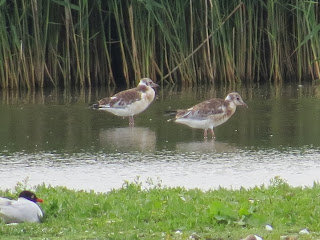 |
| Biting Stonecrop |
Things have calmed down at Minsmere since BBC Springwatch left the reserve after three weeks filming stoats, sparrowhawks and the drama of a great tit family parented by a single blue tit. Though there were plenty of people around today, it still wasn't as busy as I expect it was during those three action packed weeks. With the cameras and wires all tidied away and the film crews and production teams long gone, I thought it was about time that I checked up on the real stars of the show, the wildlife. What has happened to those stone-curlews, the avocets and the Sons of Si? That is what I wanted to know!
 |
| Southern Marsh Orchid? (Quite tall and by heathland) |
 |
| Southern Marsh Orchids |
 |
| Small Heath |
At the visitor centre, I had news that the mother stoat was reported this morning at the Island Mere Hide tackling a moorhen in the water with a lot of success! So Mum and I decided to head over there first via the track leading down the hill where the Springwatch studio building is. We saw plenty of interesting plants along the way as well as a few butterflies including a single small heath. Unfortunately, there was no sign of the stoat and at the Island Mere Hide, we could only see a pair of common terns, a few swifts, swallows and martins and a cormorant and hardly anything else. The sticklebacks (Sons of Si) were doing well and you could see plenty of them from the bridge leading to the hide.
 |
| Sticklebacks |
 |
| Four-spot Chaser |
 |
| Common Tern |
 |
| Green Woodpecker |
Walking along the bottom of the hill on our way to the Bittern Hide, we came across three people with their binoculars up. They had clearly found something, but what? It turned out to be a green woodpecker feeding amongst the grass. Its green plumage made such great camouflage that two of these people were still trying to locate it for themselves using the directions given by their friend. The five of us ended up with good views of it eventually and passers by were guided in to get a look of it, too. Unlike the other two British woodpecker species, the green woodpecker is a ground feeder, probing its long tongue into ant nests. This one spent several minutes doing just that, while also giving us the odd stare between each peck to the ground. From Bittern Hide, we saw the odd distant marsh harrier and little egret, but that was pretty much it.
 |
| Ringlet |
 |
| Sand Martin Chicks |
 |
| Stone-Curlew |
After lunch, we walked down to the beach to the East Hide. On the way, two volunteers were showing visitors the stone-curlews out on the heath through their telescopes. This was apparently the same pair that failed to hatch their egg on the show. The pair have now moved to a different location on the heath much nearer than they were before and have started again. We could see one of them sitting at the nest, while the other was walking within some scrub behind it.
 |
| Yellow Horned Poppy |
 |
| Black-headed Gull Chick |
At the East Hide, the scrapes have changed since Springwatch ended. There were black-headed gull chicks everywhere, all of them grown too big for the hungry bigger gulls that were predating them during the show. As for the avocets, there were no sign of any new chicks, at least not at the moment. I also saw a few kittiewakes and a few Mediterranean gulls out on the scrapes as well as several nesting terns. We made one last look at the stone-curlews as we made our way back to the visitor centre, discovering that a red deer had decided to have a rest on the heath several yards away from where the stone-curlews were nesting.
 |
| Black-headed Gull |
 |
| Kittiewake |
 |
| Avocet |
 |
| Mediterranean Gulls |
 |
| Black-headed Gull (above) with Mediterranean Gull (below) |
 |
| Sandwich Terns with Common Terns |
 |
| Burnet Moth |
 |
| Red Deer |
 |
| Juvenile Pied Wagtail |













































No comments:
Post a Comment